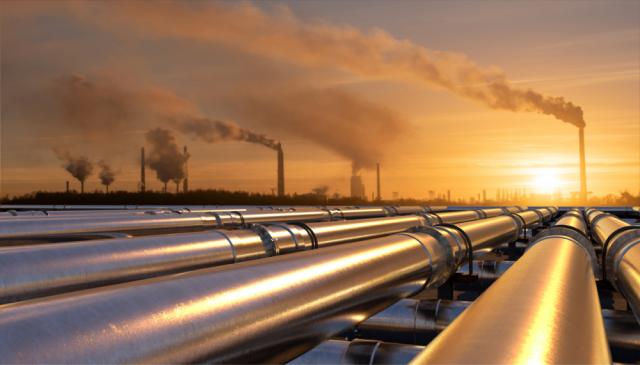
Despite the uncertainty, WoodMac Rachel Schelble believes that most Scope 1 emissions targets by Lower 48 E&Ps could be addressed by the middle of the decade, with capex reaching about $100 million to achieve those goals. (Source: Shutterstock.com)
Even with commodity markets stabilized at high prices, the E&P sector is working to identify a balance between the shifting priorities of decarbonization and achieving climate goals while also growing production and ensuring energy security.
It’s seemingly a three-wire tightrope walk between appeasing investors who want both a return and prioritize rewarding those who achieve emissions reductions, a federal government whose tone has changed from restricting drilling to pushing for more production to combat high gas prices, offset import losses from Russia, and supply global markets who have similarly cut off Russian oil and gas.
“Lower 48 E&Ps are really working hard to strike the balance between energy security and the energy transition,” said Rachel Schelble, head of corporate carbon management and infrastructure at Wood Mackenzie, speaking recently at Hart Energy’s Carbon Management Conference in Fort Worth, Texas.
“They are getting pressure to increase production due to the increased demand on oil and gas from the war in Ukraine,” she continued. “And then, of course, they are working to reduce emissions as part of the energy transition, which is in full force from investors and the public. But high commodity prices are helping them rise to that challenge in a really productive way.”
Schelble believes that most Scope 1 emissions targets could be addressed by the middle of the decade, with capex reaching about $100 million to achieve those goals.
“
It is taking a long time to show fruition in these carbon management plans. Some companies are using technologies that are still in the pilot stage. As part of carbon management plans, companies are also having to be extremely forward-thinking in emissions policy uncertainty.”—Rachel Schelble, Head of Corporate Carbon Management and Infrastructure, Corporate Service, Wood Mackenzie
Companies like ConocoPhillips, Devon Energy, EOG Resources, Pioneer Natural Resources and Chesapeake Energy have all set ambitious net-zero targets between now and 2040, while others like Marathon Oil, Hess, Callon Petroleum, Ovintiv, Murphy Oil and Diamondback Energy have set intermediate emissions reductions targets.
Occidental Petroleum has established net-zero emission goals for 2040 for its operations and products in Scopes 1, 2 and 3. The company has an “ambition to do so before 2035, and net-zero from our total carbon inventory, including the use of products, with an ambition to do so before 2050,” according to its website.
Still others, like Continental Resources, Centennial Resource Development, Matador Resources and Whiting Petroleum have no stated emissions targets.
“Some of the leading oil operators are already coming down in their methane emissions, and in the next three years could hit pretty negligible levels,” Schelble said.
However, despite rapid reductions already taking shape, the emissions reductions landscape remains cloudy as a result of few, if any, guidelines.
“We all want increased transparency on costs and carbon management plans,” Shelble said. “But essentially right now, there is no playbook, there’s no rule book for how companies can manage their carbon management, how they can structure their programs and what it’s actually going to take to achieve net-zero.”
A proposal from the U.S. Securities and Exchange Commission working its way through Congress would formalize some of those requirements and establish at least some guidelines, including reporting climate-related risks and material impacts on business and strategy, a company’s governance of climate-related risks and risk management practices and greenhouse-gas emissions reporting.
Schelble acknowledged that the industry is still in the “early innings” of setting defined pathways to net-zero, and concerns over scalability, policy uncertainty and a need for more bespoke solutions could serve as barriers to significant progress.
Identifying emissions sources, Schelble said, “is getting easier and cheaper,” with companies deploying a variety of technologies that include aerial flyovers and ground surveys, cameras and infrared sensors. And according to Wood Mackenzie, the industry has already identified the main emitting culprits: combustion equipment, which emits up to 35 million metric tonnes of CO₂-equivalent annually, and pneumatic devices, whose annual methane emissions equate to about 25 million metric tonnes of CO₂-equivalent.
However, the technologies to help reduce emissions from such devices are long-dated, as Schelble explained.
“It is taking a long time to show fruition in these carbon management plans,” she said. “Some companies are using technologies that are still in the pilot stage. As part of carbon management plans, companies are also having to be extremely forward-thinking in emissions policy uncertainty.”
One of the most common technologies being deployed in the oil field currently are replacing or retrofitting high-bleed pneumatic devices, since they have a low-cost, high-impact result. By far the most impact application in terms of carbon abatement is vapor recovery units, which, according to Wood Mackenzie, can cost between $150,000 and $300,000 per unit.
Another technology gaining traction is direct air capture (DAC), which captures CO₂ directly from the atmosphere.
In March, Occidental Petroleum, through its affiliate 1PointFive, announced a $1 billion investment in a DAC hub in the Permian Basin. The hub is currently in the FEED stage, with planned start-up in 2024. The Permian Basin hub is just the first of what Oxy hopes will eventually be 70 such DAC hubs around the world in place by 2035.
Recommended Reading
E&P Highlights: Jan. 29, 2024
2024-01-29 - Here’s a roundup of the latest E&P headlines, including activity at the Ichthys Field offshore Australia and new contract awards.
Deepwater Roundup 2024: Offshore Africa
2024-04-02 - Offshore Africa, new projects are progressing, with a number of high-reserve offshore developments being planned in countries not typically known for deepwater activity, such as Phase 2 of the Baleine project on the Ivory Coast.
E&P Highlights: April 1, 2024
2024-04-01 - Here’s a roundup of the latest E&P headlines, including new contract awards.
Deepwater Roundup 2024: Offshore Australasia, Surrounding Areas
2024-04-09 - Projects in Australia and Asia are progressing in part two of Hart Energy's 2024 Deepwater Roundup. Deepwater projects in Vietnam and Australia look to yield high reserves, while a project offshore Malaysia looks to will be developed by an solar panel powered FPSO.
E&P Highlights: April 15, 2024
2024-04-15 - Here’s a roundup of the latest E&P headlines, including an ultra-deepwater discovery and new contract awards.





